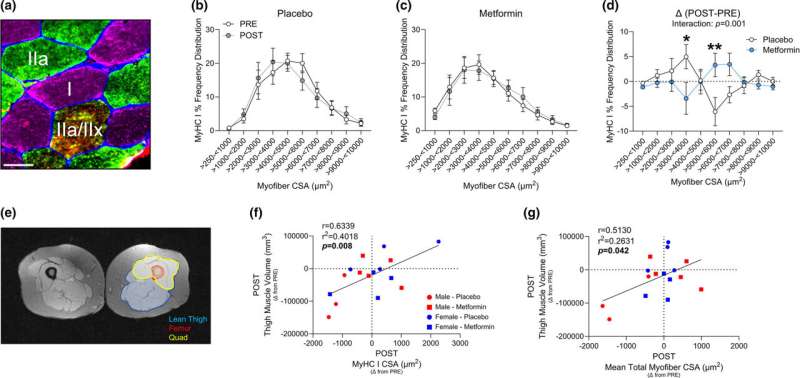This article has been reviewed according to Science X's editorial process and policies. Editors have highlighted the following attributes while ensuring the content's credibility:
fact-checked
peer-reviewed publication
trusted source
proofread
Common diabetes drug can also prevent muscle atrophy and muscular fibrosis

You might not think of diabetes when you think of muscle function. But a common diabetes drug that regulates blood sugar can also prevent muscle atrophy and muscular fibrosis—which can help the elderly bounce back faster from injury or illness.
University of Utah Health researchers have discovered that Metformin, a common drug that's been used in diabetes treatment for more than half a century, has surprising applications on a cellular level. It can target "zombie-like cells," called senescent cells, which impact muscle function.
Senescent cells secrete factors associated with inflammation that may underlie fibrotic tissue, a hardening or scarring of tissues. Metformin also reduces muscle atrophy. The team's findings are published in Aging Cell.
"We're interested in clinical application of this research," says Micah Drummond, Ph.D., senior author of the study and professor of physical therapy and athletic training at the College of Health. "For example, knee surgeries in the elderly are notoriously hard to recover from. If we give a Metformin-type agent during the recovery period, could we help the muscles get back to normal faster?"
Reinvigorating muscle recovery
As adults age, they're more likely to fall, be hospitalized, or develop chronic disease, and muscle disuse increases these risks. The research team wanted to find a therapeutic solution that could properly target both disuse atrophy and muscle recovery.
There's an optimal level of senescent cells that are beneficial, no matter your age. In younger, healthier people, short-term senescence is required for a proper recovery from injury, and completely blocking the senescent effect impedes the body's efforts to heal. Typically, a younger person can bounce back more easily after muscle disuse without the use of an intervention such as Metformin.
"In the case of aging, we know that there's immune dysfunction," says Drummond. "As you get older, it becomes harder for your body to clear senescent cells and they accumulate. That's one reason recovery is much slower for the elderly after periods of disuse."
Metformin's anti-senescent properties have been demonstrated through pre-clinical studies. To test the intervention in humans, the team recruited 20 healthy male and female older adults for a multi-week study. They had participants undergo a muscle biopsy and MRI before the intervention, which involved five days of bed rest. One group of 10 received Metformin and the other 10 received placebo pills during a two-week run-in period, then each group continued the placebo or Metformin treatment during bed rest.
After the bed rest, participants received another muscle biopsy and MRI, then ceased treatments. All patients completed a seven-day re-ambulation period followed by a final muscle biopsy.
"We saw two things in our study," Drummond says. "When participants took Metformin during a bed rest, they had less muscle atrophy. During the recovery period, their muscles also had less fibrosis or excessive collagen. That build-up can make it harder for the muscle to properly function."
Tying these results to senescence, the research team examined muscle biopsies from study participants. They found that the participants who took Metformin had fewer markers of cellular senescence.
"This is the first paper that has made the direct connection between a therapy targeting cellular senescence and improved muscle recovery following disuse in aging," says lead author Jonathan Petrocelli, Ph.D. He explains that metformin helps muscle cells better remodel and repair tissue during periods of recovery after inactivity.
"Our real goal is to have patients maintain their muscle mass and function as they age, because atrophy and weakness are some of the strongest predictors of disease development and death," he says.
Drummond's team is following up on these findings by examining combining the drug with leucine, an amino acid that promotes growth and could accelerate recovery even further. They've already demonstrated the potency of this combination in preclinical animal studies.
"Metformin is cheap, effective and quite safe, so it's exciting to see that we can use it to accelerate recovery for older individuals," adds Drummond.
More information: Jonathan J. Petrocelli et al, Disuse‐induced muscle fibrosis, cellular senescence, and senescence‐associated secretory phenotype in older adults are alleviated during re‐ambulation with metformin pre‐treatment, Aging Cell (2023). DOI: 10.1111/acel.13936




















